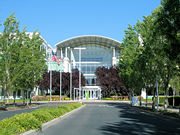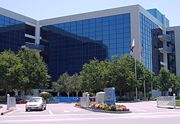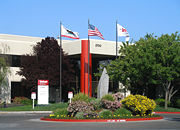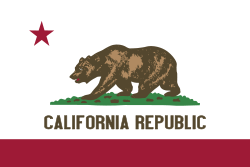Silicon Valley
- For the valley nicknamed "Silicone Valley" see San Fernando Valley.

Silicon Valley is the southern part of the San Francisco Bay Area in Northern California, United States. The term originally referred to the region's large number of silicon chip innovators and manufacturers, but eventually came to refer to all the high-tech businesses in the area; it is now generally used as a metonym for the high-tech sector. Despite the development of other high-tech economic centers throughout the United States, Silicon Valley continues to be the leading high-tech hub because of its large number of engineers and venture capitalists. Geographically, Silicon Valley encompasses the northern part of Santa Clara Valley and adjacent communities.
Contents |
Origin of the term
The term Silicon Valley was coined by Ralph Vaerst, a Northern California entrepreneur. Its first published use is credited to Don Hoefler, a friend of Vaerst's, who used the phrase as the title of a series of articles in the weekly trade newspaper Electronic News. The series, entitled "Silicon Valley USA," began in the paper's issue dated January 11, 1971. Valley refers to the Santa Clara Valley, located at the southern end of San Francisco Bay, while Silicon refers to the high concentration of companies involved in the semiconductor and computer industries that were concentrated in the area. These firms slowly replaced the orchards which gave the area its initial nickname, the Valley of Heart's Delight.
History
Perhaps the strongest thread that runs through the Valley’s past and present is the drive to “play” with novel technology, which, when bolstered by an advanced engineering degree and channeled by astute management, has done much to create the industrial powerhouse we see in the Valley today.[1]
Since the early twentieth century, Silicon Valley has been home to a vibrant, growing electronics industry. The industry began through experimentation and innovation in the fields of radio, television, and military electronics. Stanford University, its affiliates, and graduates have played a major role in the evolution of this area.
Social Roots of information technology revolution in America
It was in Silicon Valley that the integrated circuit, the microprocessor, the microcomputer, among other key technologies, were developed, and that the heart of electronics innovation has beaten for four decades, sustained by about a quarter of a million information technology workers. Silicon Valley was formed as a milieu of innovations by the convergence on one site of new technological knowledge; a large pool of skilled engineers and scientists from major universities in the area; generous funding from an assured market with Defense Department; the development of an efficient network of venture capital firms; and, in the very early stage, the institutional leadership of Stanford University. [2]
Roots in radio and military technology
The San Francisco Bay Area had long been a major site of U.S. Navy research and technology. In 1909, Charles Herrold started the first radio station in the United States with regularly scheduled programming in San Jose. Later that year, Stanford University graduate Cyril Elwell purchased the U.S. patents for Poulsen arc radio transmission technology and founded the Federal Telegraph Corporation (FTC) in Palo Alto. Over the next decade, the FTC created the world's first global radio communication system, and signed a contract with the U.S. Navy in 1912.[1]
In 1933, Air Base Sunnyvale, California was commissioned by the United States Government for the use as a Naval Air Station (NAS) to house the airship USS Macon in Hangar One. The station was renamed NAS Moffett Field, and between 1933 and 1947, US Navy blimps were based here.[3] A number of technology firms had set up shop in the area around Moffett to serve the Navy. When the Navy gave up its airship ambitions and moved most of its West Coast operations to San Diego , NACA (the National Advisory Committee for Aeronautics, forerunner of NASA) took over portions of Moffett for aeronautics research. Many of the original companies stayed, while new ones moved in. The immediate area was soon filled with aerospace firms such as Lockheed.
Stanford Industrial Park
After World War II, universities were experiencing enormous demand due to returning students. To address the financial demands of Stanford's growth requirements, and to provide local employment opportunities for graduating students, Frederick Terman proposed the leasing of Stanford's lands for use as an office park, named the Stanford Industrial Park (later Stanford Research Park). Leases were limited to high technology companies. Its first tenant was Varian Associates, founded by Stanford alumni in the 1930s to build military radar components. However, Terman also found venture capital for civilian technology start-ups . One of the major success stories was Hewlett-Packard. Founded in Packard's garage by Stanford graduates William Hewlett and David Packard, Hewlett-Packard moved its offices into the Stanford Research Park slightly after 1953. In 1954, Stanford created the Honors Cooperative Program to allow full-time employees of the companies to pursue graduate degrees from the University on a part-time basis. The initial companies signed five-year agreements in which they would pay double the tuition for each student in order to cover the costs. Hewlett-Packard has become the largest personal computer manufacturer in the world, and transformed the home printing market when it released the first ink jet printer in 1984. In addition, the tenancy of Eastman Kodak and General Electric made Stanford Industrial Park a center of technology in the mid-1990s.[4][5]
Silicon transistor
In 1953, William Shockley left Bell Labs in a disagreement over the handling of the invention of the transistor. After returning to California Institute of Technology for a short while, Shockley moved to Mountain View, California in 1956, and founded Shockley Semiconductor Laboratory. Unlike many other researchers who used germanium as the semiconductor material, Shockley believed that silicon was the better material for making transistors. Shockley intended to replace the current transistor with a new three-element design (today known as the Shockley diode), but the design was considerably more difficult to build than the "simple" transistor. In 1957, Shockley decided to end research on the silicon transistor. As a result, eight engineers left the company to form Fairchild Semiconductor. Two of the original employees of Fairchild Semiconductor, Robert Noyce and Gordon Moore, would go on to found Intel.[6]
Venture capital firms
By the early 1970s there were many semiconductor companies in the area, computer firms using their devices, and programming and service companies serving both. Industrial space was plentiful and housing was still inexpensive. The growth was fueled by the emergence of the venture capital industry on Sand Hill Road, beginning with Kleiner Perkins in 1972; the availability of venture capital exploded after the successful $1.3 billion IPO of Apple Computer in December 1980.
The rise of software
Although semiconductors are still a major component of the area's economy, Silicon Valley has been most famous in recent years for innovations in software and Internet services. Silicon Valley has significantly influenced computer operating systems, software, and user interfaces.
Using money from NASA and the U.S. Air Force, Doug Engelbart invented the mouse and hypertext-based collaboration tools in the mid-1960s, while at Stanford Research Institute (now SRI International). When Engelbart's Augmentation Research Center declined in influence due to personal conflicts and the loss of government funding, Xerox hired some of Engelbart's best researchers. In turn, in the 1970s and 1980s, Xerox's Palo Alto Research Center (PARC) played a pivotal role in object-oriented programming, graphical user interfaces (GUIs), Ethernet, PostScript, and laser printers.
While Xerox marketed equipment using its technologies, for the most part its technologies flourished elsewhere. The diaspora of Xerox inventions led directly to 3Com and Adobe Systems, and indirectly to Cisco, Apple Computer and Microsoft. Apple's Macintosh GUI was largely a result of Steve Jobs' visit to PARC and the subsequent hiring of key personnel. Microsoft's Windows GUI is based on Apple's work, more or less directly.[7] Cisco's impetus stemmed from the need to route a variety of protocols over Stanford's campus Ethernet.
Internet bubble
Silicon Valley is generally considered to have been the center of the dot-com bubble which started from the mid-1990s and collapsed after the NASDAQ stock market began to decline dramatically in April 2000. During the bubble era, real estate prices reached unprecedented levels. For a brief time, Sand Hill Road was home to the most expensive commercial real estate in the world, and the booming economy resulted in severe traffic congestion.
Even after the dot-com crash, Silicon Valley continues to maintain its status as one of the top research and development centers in the world. A 2006 Wall Street Journal story found that 13 of the 20 most inventive towns in America were in California, and 10 of those were in Silicon Valley. [8] San Jose led the list with 3,867 utility patents filed in 2005, and number two was Sunnyvale, at 1,881 utility patents.[9]
Economy
According to a 2008- study by AeA in 2006 Silicon Valley was the third largest (cybercity) high-tech center in the United States, behind NYC Metro and DC Metro, with 225,300 high-tech jobs. Although if CMSA is considered the Bay Area, which Silicon Valley is part of, ranked #1 with 386,000 high-tech jobs. Silicon Valley has the highest concentration of high-tech workers of any metropolitan area, with 285.9 out of every 1,000 private-sector workers. It also tops cybercities with the highest average high-tech salary of $144,800. The region is the biggest high-tech manufacturing center in the United States.[10]
Notable companies
- See also: Category:Companies based in Silicon Valley
Thousands of high technology companies are headquartered in Silicon Valley; among those, the following are in the Fortune 1000:











- Adobe Systems
- Advanced Micro Devices (AMD)
- Agilent Technologies
- Apple Inc.
- Applied Materials
- Business Objects
- Cisco Systems
- eBay
- Hewlett-Packard
- Intel
- Intuit
- LSI Logic
- Maxtor
- National Semiconductor
- NetApp
- Nvidia
- SanDisk
- Symantec
- Sun Microsystems
- Yahoo!
Additional notable companies headquartered (or with a significant presence) in Silicon Valley include (some defunct or subsumed):
- 3Com (headquartered in Marlborough, Massachusetts)
- Actel
- Actuate Corporation
- Adaptec
- Amdahl
- Aricent
- Asus
- Atari
- Atmel
- Broadcom
- BEA Systems
- Cypress Semiconductor
- Force10
- Foundry Networks
- Fujitsu (headquartered in Tokyo, Japan)
- Hitachi Global Storage Technologies
- IBM Almaden Research Center
- Juniper Networks
- Logitech
- McAfee
- Memorex (acquired by Imation and moved to Cerritos, California)
- Microsoft (headquartered in Redmond, Washington)
- Netflix
- Netscape (acquired by AOL)
- NeXT Computer, Inc. (acquired by Apple)
- Opera Software
- OPPO
- Palm, Inc.
- PalmSource, Inc. (acquired by ACCESS)
- PayPal (now part of eBay)
- Rambus
- Redback Networks
- SAP AG (headquartered in Walldorf, Germany)
- Siemens
- Silicon Graphics
- Silicon Image
- Solectron (acquired by Flextronics)
- Sony
- SRI International
- SunPower
- Tesla Motors
- Tellme Networks (acquired by Microsoft)
- TiVo
- VA Software (Slashdot)
- WebEx (acquired by Cisco Systems)
- Western Digital
- VeriSign
- Veritas Software (acquired by Symantec)
- VMware (acquired by EMC)
- Xilinx
- Zoran Corporation
Silicon Valley is also home to the high-tech superstore retail chain Fry's Electronics.
Notable government facilities
- Moffett Federal Airfield
- NASA Ames Research Center
- Onizuka Air Force Station
Universities
- Carnegie Mellon University (Silicon Valley Campus)
- San José State University
- Santa Clara University
- Stanford University
Cities
A number of cities are located in Silicon Valley (in alphabetical order):
- Campbell
- Cupertino
- East Palo Alto (San Mateo County)
- Los Altos
- Los Altos Hills
- Los Gatos
- Menlo Park (San Mateo County)
- Milpitas
- Morgan Hill
- Mountain View
- Palo Alto
- San Jose
- Santa Clara
- Saratoga
- Sunnyvale
Cities sometimes associated with the region:
- Fremont (Alameda County)
- Foster City
- Gilroy
- Newark (Alameda County)
- Redwood City (San Mateo County, home to Oracle, Electronic Arts and PDI/DreamWorks)
- Santa Cruz[11]
See also
- List of attractions in Silicon Valley
- List of places with 'Silicon' names
- List of research parks around the world
- List of technology centers around the world
- Pirates of Silicon Valley — Movie about the early development of Microsoft and Apple.
- Science park
- Silicon Valley Toxics Coalition
- Sustainable Silicon Valley (SSV)
- Silicon Forest
Further reading
- Making Silicon Valley: Innovation and the Growth of High Tech, 1930-1970 by Christophe Lécuyer, MIT Press (2006)
- Hackers: Heroes of the Computer Revolution by Steven Levy, Garden City, New York: Anchor Press/Doubleday (1984)
- Behind the Silicon Curtain: The Seductions of Work in a Lonely Era, Dennis Hayes, London: Free Association Books (1989)
- Silicon Valley, Inc.: Ruminations on the Demise of a Unique Culture, The San Jose Mercury News (1997)
- Cultures@Silicon Valley, J. A. English-Lueck, Stanford: Stanford University Press (2002)
- The Silicon Valley of Dreams: Environmental Injustice, Immigrant Workers, and the High-Tech Global Economy, David Naguib Pellow and Lisa Sun-Hee Park, New York University Press (2003)
- What the Dormouse Said: How the Sixties Counterculture Shaped the Personal Computer Industry, John Markoff, Viking (2005)
- Silicon Follies: A Dot. Comedy, Thomas Scoville, Pocket Books (2000)
- The Silicon Boys: And Their Valleys Of Dreams, David A. Kaplan, Harper Perinneal (April 2000), ISBN 0-688-17906-1
- Cities of knowledge: Cold War science and the search for the next Silicon Valley, Margaret Pugh O’Mara, New Jersey: Princeton University Press, (2005)
- Accidental Empires: How the boys of Silicon Valley make their millions, battle foreign competition, and still can't get a date, Robert X. Cringely, Addison-Wesley Publishing, (1992), ISBN 0-201-57032-7
References
- ↑ 1.0 1.1 Timothy J. Sturgeon, Massachusetts Institute of Technology | Timothy J. Sturgeon, Massachusetts Institute of Technology SV GlobalizationPDF (90.0 KiB)
- ↑ The Information Technology Revolution by Marvel Castells (On the history of formation of Silicon Valley by Rogers and Larsen 1984 and Malone 1985)
- ↑ moffettfieldmuseum
- ↑ 1984 printer
- ↑ SV History
- ↑ Goodheart July 2, 2006
- ↑ [http://inventors.about.com/library/weekly/aa043099.htm Inventors of the Modern Computer: The History of the Graphical User Interface or GUI - The Apple Lisa] by Mary Bellis
- ↑ Reed Albergotti, "The Most Inventive Towns in America," Wall Street Journal, 22-23 July 2006, P1.
- ↑ Ibid.
- ↑ Silicon Valley and N.Y. still top tech rankings
- ↑ Silicon Valley. "Silicon Valley Online". Retrieved on 2007-11-11.
External links
- How Silicon Valley Came to BePDF (90.0 KiB)
- California's Historic Silicon Valley
- Reference about Don Hoefler
- Website focused on Silicon Valley news, backed by the San Jose Mercury News
- Silicon Valley 150 for beginning of 2004 as a PDF filePDF
- The Silicon Valley Cultures Project
- Stanford Linear Accelerator center
- Growth of a Silicon Empire by Henry Norr published at the end of 1999 in the San Francisco Chronicle
- Douglas Engelbart
- Red tile roofs in Bangalore: Stanford's look copied in Silicon Valley and beyond
|
|||||||||||
|
||||||||||||||||||||||||||||||||
|
